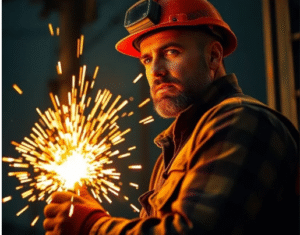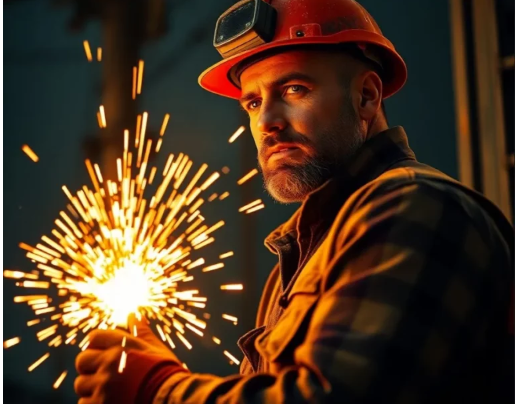Construction Electrical Safety: Reducing Shock and Fire Risks
Construction Electrical Safety Reducing Shock and Fire Risks. On building sites, electrical safety takes front stage. One incorrect action might cause deadly flames, major injuries, or electric shocks. There are several risks on building sites; one of the most deadly is electricity. Accidents can result from exposed wires, broken tools, overloaded circuits, etc. Employers and employees have to so give electrical safety first importance.
Following safety guidelines and knowing the hazards helps one to preserve life. It’s not only about avoiding injuries; it also about avoiding expensive damage to property and equipment. Most electrical mishaps can be avoided, fortunately, with the correct care.

Knowing Electrical Safety Issues
Though it is strong, electricity is also erratic. One error may do great damage. Staying safe requires first awareness of the hazards. These are some of the most often occurring electrical risks present on building sites.
LiveWires
Among the largest dangers are live wires. They can be left exposed from inadequate insulation or buried under walls. Even by mistake, touching a live wire can result in extreme electric shock. Sometimes it can be lethal.
Just as hazardous are damaged cables. Should insulation wear out or break, the wire may spark and start a fire. All cables should thus be correctly insulated and kept free from workers’ path of travel.
Malfunctioning tools
Builders depend on generators, heavy-duty power tools, and machinery. When equipment breaks, though, it presents a major hazard. Electric shocks or maybe explosions might result from a frayed power wire or a damaged plug.
Many times, workers operate in difficult environments—rain, dirt and dust. Should moisture enter electrical equipment, electrocution becomes more likely. Tools and machinery should so always be checked before using.
Insufficient Wiring and Overloaded Circuit Design
Major difficulties can result from bad wiring. Inappropriate setup of circuits could cause them to overheat and ignite a fire. Still another problem are overloaded circuits. Overheating and sparking a single outlet from too many tools plugged into it might result from this.
Though overloading them is dangerous, extension leads are often utilized on sites. Using a too lengthy extension or the incorrect kind of cable could cause voltage dips, overheating, even electrical fires.
Through courses in construction safety, employee training guarantees that workers know frequent hazards and how to reduce risk.
Legal Notifications for Electrical Safety
Strong legislation control electrical safety on building sites in the United Kingdom. These guidelines help to safeguard employees and guarantee that facilities are free from electrical risks. Companies have rules they must abide by to protect their staff.
Workplace Health and Safety Act
Employers have to do risk analyses and act to lower hazards. Should they neglect this, they run the risk of suffering major injuries on site or hefty fines.
Best Practices in Electrical Safety
Reducing electrical risks mostly depends on following optimal standards. Employees must remain vigilant and companies have to enforce rigorous safety policies. These are some of the greatest strategies for underlining control of electrical hazards.
Frequent Maintenance and Inspections
Regular inspections help avoid mishaps. Additionally routinely tested should be electrical systems.
To guarantee their safety, this covers verifying outlets, wiring and circuits. Frequent maintenance helps find possible risks before they become major concerns.
Appropriate Operation of Electrical Tools
Correct use of electrical tools is absolutely important. Before plugging in machinery, staff members should carefully look for broken cables and plugs.
Keep power tools dry and far from water. Workers should also avoid overloading sockets and apply the proper voltage for every tool. Simple steps like these help to stop shocks and flames.
Workplace Safety Training
Among the best strategies to lower electrical mishaps is training. Employees must be knowledgeable in safe handling of electrical tools.
Courses in electrical safety teach employees about appropriate wiring, safe tool use, and what to do should an electric shock strike. A well-trained crew is less prone to make mistakes that can cause major injuries.
Inventive safety technologies
Constructing sites are becoming safer because to technology. New safety instruments enhance threat identification and help to prevent electrical mishaps. These are few of the most recent developments in electrical safety.
Ground-fault circuit interrupters (GFCIs)
GFCIs are life savors. Should they find an electrical malfunction, they turn off power automatically. This lowers the danger of fires and helps to avoid electric shocks.
Every power outlet on building sites should have GFCIs fitted.
Electronic Sensor Technology Wireless
Using these sensors helps building sites avoid electrical fires and lower equipment risk of malfunction.
In essence,
One error might cause a terrible fire or an accident that kills. Wireless sensors and GFCIs are lowering the electrical shock and fire hazards.
Combining modern technologies with appropriate safety practices can help building sites to be far safer locations for employment. Employees have to be alert, obey safety rules, never gamble with electrical systems.
